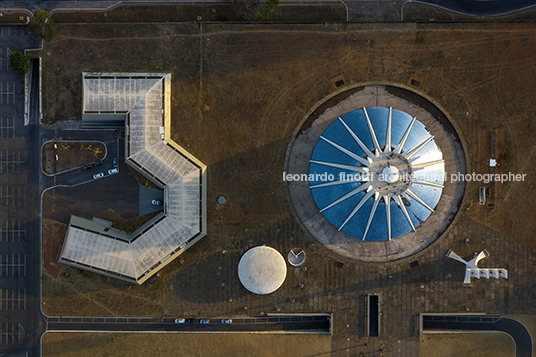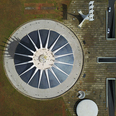catedral metropolitana brasília df, brazil
- description
On 12th September 1958, the Cathedral’s cornerstone was laid. The Metropolitan Cathedral of Brasilia is an expression of the geniality of the architect Oscar Niemeyer. In 1960, the Cathedral’s structure was finished, and only the 70 m diameter of the circular area and the 16 concrete columns were visible. These columns, having parabolic section and weighing 90 t, represent two hands moving upwards to heaven. The Cathedral was dedicated on the 31st May, 1970. At that time it had already the external transparent window.
Evangelists
Evangelists sculpturesFour bronze sculptures 3 m high, representing the Evangelists, can be seen at the external square in the entrance of the Temple. These sculptures were made with the help of the sculptor Dante Croce, in 1968.
Inside the nave, three sculptures of angels are suspended by steel cables. The smallest angel has 2,22 m of length and weighs 100 kg. The medium one has 3,40 m of length and weighs 200 kg. The big one has 4,25 m of length and 300 kg weighs. The sculptures were made by Alfredo Ceschiatti, with the help of Dante Croce, in 1970.
Having an oval form, the Baptistery has its walls covered by a panel of ceramic tiles painted in 1977 by Athos Bulcão. The local architecture is completed by a bell tower. Its four big bells were donated by Spain.suspended angels
The nave stained glass is made of 16 pieces of fibreglass. These pieces, in colours of blue, white and brown, were fixed between the concrete columns, in triangles of 10 m of base and 30 m of height. They were painted in 1990 by Marianne Peretti.
The Altar was donated by Pope Paul VI and the image of the Patroness Our Lady of Aparecida is an replica of the original which is at Aparecida do Norte, São Paulo.
Di Cavalcanti made the Way of the Cross, which can be seen in one of the marble walls. Just at the entrance of the Cathedral there is a marble pillar with pictures of some passages of the life of Our Lady, the Mother of God, painted by Athos Bulcão.Inside the crypt, there is a reproduction of the Shroud of Turin. The Shroud of Turin is the piece of pure linen cloth that was used to cover the body of Jesus Christ after his crucifixion and before He was laid in the Holy Sepulchre. The original one is today at Turim, Italy (that is why it is known as the Shroud of Turin). It is 4,36 m length by 1,10 m width.
On the cloth there are stains of human blood, with the marks of Jesus of Nazareth’s scourging and torment. This cloth is the biggest evidence that Jesus existed indeed and what he suffered. After the Shroud of Turin was photographed in 1898, it became easier to study it under the light of science, due to the definition of the front and the back of the figure. Since then there have being many discussions about it without the specific religious point of view, helping to bring about its acceptance by everyone, every race and every religion. It is, doubtless, a relic which has much to enlighten the History of Humanity.vitrals Brasiia church
The parish priest of the Cathedral is Monsignor Marcony Vinicius Ferreira, the first priest born and ordained in Brasilia. Due to its location at the Esplanada dos Ministérios, the Cathedral does not have a fixed community. The majority of the faithful that normally come to the Cathedral are either tourists or those that work at the Esplanada dos Ministérios.


































